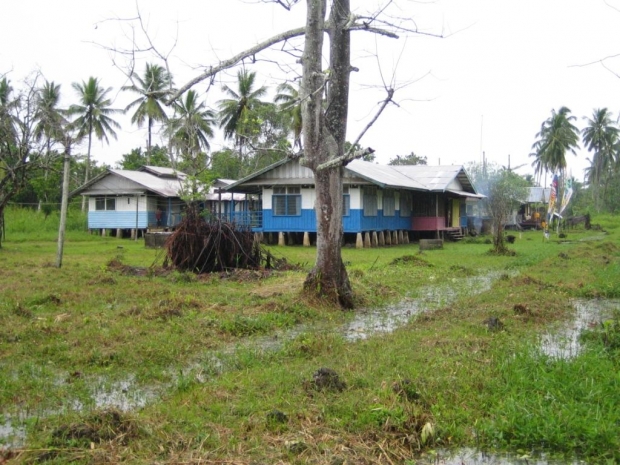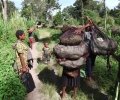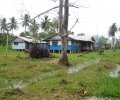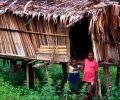My First Job
“You don’t change” or “You’re still the same” is invariably said by the people I ran into after years—up to 30 years—of our parting. The sameness they mean includes both physical appearance and personality traits. I am glad—not because I look younger for my age—that I am able to escape from the power of my social position dictating my attitude, behavior, and interaction with others. Almost everybody succumbs to this power: position changes—mostly promotion—attitude and behavior change—mainly negatively. More money, more power, less true friends.
The main purpose of my trip was to find a non-government hospital in Papua, and there was only one option available: the Mission hospital in Asmat. I knew that I would not be compatible with the Government people—confirmed by my father: ‘He has a problem with following order and being diplomatic.” There were to airlines to fly to Asmat: Merpati, the Government’s, and AMA, the Catholic Mission’s. Merpati was much cheaper, but I had to fly first from Jayapura to Merauke, 1.5 hours, and another 1.5 hours from Merauke to Ewer, the airstrip of Asmat. Making it more complicated, Merpati only flew once a week to Ewer—the chance to get a seat was very slim, only 18 available. Travelling in Papua will never be cheap and easy.
Flying with Cessna airplane is always fun. It flies low—a few meters above the ground; only in a very cloudy weather it flies above 10,000 feet—and slow, about 300 kilometer per hour. This time I was lucky to sit by the pilot so that I could see the landscape below and the mountainsides very clearly; I could even see individual bird perching on the canopies or flying over the rivers. Flying following the rivers is very thrilling, especially when they end up as waterfalls. And, there were hundreds of waterfalls in Papua, from 5 meters to hundreds meters.
The distance Sentani (Jayapura airport) to Ewer is around 600 kilometer, about 2-hour flight by Cessna. The first hour is very diverse landscapes: ocean, sago forest, lake, hill, river, gorge, valley, mountain, waterfall, and montane forest. However, once passing the southern mountain range the Central Highland, we will only see one landscape for hundreds kilometers: the lowland tropical rainforest.
Flying over the lowland tropical rainforest is like flying over a green carpet: trees, trees, and trees. I had never seen so many trees and so wide, long, and winding rivers in my life. Here and there are the oxbows. The water runs very slowly; how long does it take to form one lake from an oxbow?
While in Java you will see houses anytime and anywhere, here I only saw one or two little thatched huts, mostly by the rivers, every 10-minute flying. It is bivouac, the shelter during gathering food, according to Urs, the AMA pilot. It was really a different world, the world hardly without us, the world of beauty.
We were flying very low, probably around 300 meters above sea level. The altitude of the forest is not more than 25 meter, and the highest canopy around 100 meter. Flying low saves fuel a lot. Of course, it is risky too because Cessna has only one engine. Anyway, travelling and living in the interior has never been without risky; it is even riskier in 2013 due to the unpredictable behavior of modern Papuans.
“The Arafura Sea,” Urs the pilot pointed the horizon straight ahead. It was the line where the green ended. It took us another fifteen minutes before we saw a cluster of hundreds of modern houses: Agats, the center of Asmat region. We did not fly over it but to its right side. The Cessna passed over a river and turned around before landing roughly and noisily on the runway of Ewer airstrip.
It was quite strange the Cessna was felt taxied on the road that was full of holes: bumpy and cracking. It was indeed, I found out on the ground. The runway was made of hundreds of holed metal plates connected loosely. Urs told me that the Allies under General McArthur had used those plates during the Second World War, 50 years before! Why did they not build a normal one? The answer is easy: there is no single rock or stone in these swampy areas—thousands of square kilometer—and the soil is purely mud and flooded during the high tide.
I knocked at the door of the wooden house where I heard the communication radio (SSB). A white woman, around 60, opened the door.
“Suster, I am Ating.” We shook hands and I introduce myself. I guessed she was a nun although she did not wear a robe—I had heard her voice from Sentani’s SSB.
“I am Suster Dee,” Sister Concilia Dee Yanshaak, OSU, was her full name. OSU is Order of Saint Ursula.
“Suster, may I use the SSB for contacting Pater Ton van der Wouw in Basiem?” She led me to the radio table at the corner of the front room. Pater had expected me; he later talked to and asked Suster Dee to arrange a room for me in the guesthouse of Agats diocese.
“You are a doctor,” Dee said after the radio conversation had been over.
“Yes, Suster.”
She shook my hands—for the second time and tighter. “I thought you were a student of senior high school.” I looked younger ten years than my age in her eyes.
Shaking hands twice with the same person at the same occasion is ‘normal’ for me: the first one as Ating Only, the second Doctor Ating. I enjoy—with disgust, sometimes—observing the change of attitude and behavior of my handshake partner before and after the second handshake. Invariably, they stop looking down on me, if they did; they are more polite and show respect for me, often too much. They are putting on their ‘mask’.
In introducing myself, I rarely add ‘Dr’ in front of my name. I want to know people as they are and want them to know me as a human being, not a profession. Their reactions on finding out me a doctor are often interesting. For instance, in one conference of AAA (the Association of American Anthropologists) in Washington DC in 1995, a discussion group mate said I did not look like a doctor. Replying to my ‘Why’, he said, “You are not arrogant.” He was not entirely wrong about arrogant doctor.
In the hospitals, we can see the stereotype of arrogant doctors is often confirmed. Most doctors, at least in Indonesia, only nod their heads—some might act like a zombie—in returning the greetings from nurses, patients, interns, and, especially, cleaning service staff. I pity on them, the doctors. Trying to match our attitude and behavior to our position is exhausting and artificial. Losing our faithful and honest friends is the worst impact. “He is not as friendly and helpful as before” was the common opinion on a colleague of mine after his promotion about two years ago. He is not a doctor. Thus, it is the socioeconomic change that removing positive attitude and behavior. Nurture seems stronger than nature.
On some occasions, I introduce ‘Doctor Ating’ from the very beginning. By this way, I will have my ID cards and passport finished sooner; receptionists of five star hotels will believe easier that my company will pay my bill; or my very sick friends will be handled right away in the emergency room. This ‘Dr’ title is very useful in these situations.
$100 Salary
Answering the question “How much do you expect your salary?” has never been easy for me. Over 25 years, my qualification has increased steadily, but my remuneration has not. Even my education in USA—which was very costly—did not kick it up. My first salary (1990) was $100 and 20 year later $300. It is nobody’s fault, but mine.
Sister Dee asked her motorist (boat driver) Domin, an Asmat man, to take me to Agats with a slup—a Dutch name for speedboat. Made of aluminum, the slup can carry 6 to 10 passengers, depending on its size and engine power. We went south and then turned east at the mouth of River Pek to enter River Asewet. It is the widest river I had ever seen, about 300 meters at its mouth.
The diocese was the largest complex in Agats. Its buildings were well made, high quality wood called ‘iron wood’. People said they could last more than a hundred years. The guest rooms were cozy: excellent ventilation and lighting, clean, and comfortable bed. The electricity was on until 11 p.m.
The town was built on the wooden planks supported by stilts, around two meters at low tide. Moving around in the evening was dangerous because of no light and of missing planks—many people had broken bones from falling to the ground underneath. The inhabitants were mostly straight hair: merchants from South Sulawesi, Government officials, police, soldiers, and missionary’s employees and clergies. The prices were not as high as in the highland—merchandise brought in by ships—but still very expensive comparing with the ones in Java.
Two days later, I returned to Ewer and flew to Basiem. By boat, it takes 4 to 6 hours, but by Cessna only 10 minutes. This 10-minute fly was impressive. The Cessna flew south along the coast. The meanders were so wide; the trees were so dense and tall, and the mangroves gradually replaced them. It is the largest mangrove biota in Asia, one of the richest biodiversity ecoregions. From the top, we could only see birds; they were so many in clusters and so colorful; cockatoos and lorries were the dominant species. We passed only 4 -5 hamlets along the coast; each consisted of 3 – 5 long houses. However, Basiem was very populated, more 30 long houses.
The Cessna circled Basiem twice, crossed a river, and landed on the grassy airstrip. All but one person were dark skin and curly hair. The white little man greeted me on getting off the plane. “Ton van der Wouw,” he introduced himself. “Wait a second. I am taking care of the flight first.”
The Dutch people are tallest on average in the world, but Ton was less than 160 cm. He was about 60 or older; I was not sure because he stooped. He had lived in Basiem around 32 years! He took me to his house called pastoran (presbytery) after the plane taking off.
The presbytery was only a few meters from the airstrip. At the entrance, we met two women working with medicine on a table. “This is Antonia. She takes care of the patients.” He introduced me to the first woman, “this one is Cecilia. She helps Antonia. We serve the patients here.” Both of them were Asmat. Ton had trained these illiterate women; now they were able to write simple medical instructions and treat sick people. I bet it took Ton years of teaching and a lot of patience to make them so good.
I smelt something stink on entering the house. Feces! Yes, they must belong to three children in the room, two on the floor, and one on the bosom of a young girl. “This is Paskalis and Natalis. That one Barnabas,” Ton pointed to the one on the floor and on the bosom. He continued with the story how those three young children—Barnabas was still a baby—ended up in his house. Barnabas was a baby of a teen sent to school in Agats; the other two had their mothers die on delivering them. They all lived with Ton during the day, with the sitter during the night.
“What do you like to drink, Doctor?”
“Just water, Pater.”
“Let’s see if I have drinking water.” He left the house and came back soon. “Sorry, doctor. I have only Fanta and coffee.”
“I don’t drink coffee. Fanta is OK.” Later I found out he only drank either coffee or beer; sometimes water, unboiled rainwater. They were typical liquids the Dutch missionaries drank; as I worked with them most of the time, I had to adjust myself—started drinking coffee, but not beer; I am allergic to beer.
Ton knew a lot—must be more than I did on local diseases—about medicine. He had wanted to be a doctor, but got lost into a seminary of MSC (Missionaries of the Sacred Heart)—some of us tease them “Masih Suka Cewek” = still like girls). He then took me to the Puskesmas, the primary health center of the Government, about 100 meters from his house.
“Antonia lived in the next building,” said he. “That is her husband. Lazybones,” Pater pointed to a big muscular man sitting in front of the building. There were many people sitting on the floor in front of the Puskesmas. All children were dirty; most of them had runny nose; the young ones were naked.
We passed them. “Petrus, this is Doctor Ating. He will work at the Bayun Hospital.” Ton introduced me to a young man sitting in front of a binocular microscope. Impressive! A young Asmat with sophisticated equipment. “Petrus is microscopist. He checks malaria and tuberculosis smears.” That was more than impressive because I could not do it by myself. A Dutch doctor had initially trained Petrus and then Ton sent him to Jayapura for further training. For quality control, his read slides were sent to Jayapura periodically. He got A. Better than most Government microscopists in Jayapura.
From Puskesmas, we explore the village. The Asmat lived in long houses, 8 to 12 families each. We could find out easily the number because each lived around one fire. Just imagine how crowded that single room house in the evening is; each family typically consisted of 4 – 7 persons. Ton took me to the church first, a three quarter ring building, the largest building in the village. All the poles were crafted with primitive arts. The altar was surrounded with long benches, except the last row.
We climbed the largest house. “Bachelor house,” Ton explained. I did not look at him because I was watching my steps. The stair was a toothed pole—about 2.5 meters; it was moving when I climbed it, forcing me crawling like a monkey climbing a tree. The Asmats climbed it erect. It was dark inside. After a few moments, I could see some men—only men and boys were allowed to enter the house. The men were busy crafting wood, the famous Asmat handicraft.
“Good afternoon, Pater,” some women sitting on the porch greeted Ton.
“What are doing there?”
“Just sitting.” Yes, the Asmats love doing nothing if the food is still enough for a few weeks.
The next day we went to Bayun by boat. It took us about ten minutes to reach the mouth of River Fayit; another 40 minutes before approaching the coast. “River Kronkel,” Ton pointed to the left. For a while, I could not spot the river mouth until we got closer ashore; two color coasts: black on the left, white on the right; the center was the river.
Some houses were on the white coast but I did not think they were the mission houses. We went ashore but stuck in the mud after the engine was turned off; the shoreline was still about 50 meters ahead. Many people lined the coast and some of them pushed our board closer to the water line. Bayun looked beautiful: white sand and coconut trees.
We passed a narrow short path lined by casuarina trees—Ton informed the name of the trees. The area is named Casuarinen Coast. People were following us with our stuff. What a helpful people!
“We will stay in the presbytery. The priest is in Jayapura now.”
They all brought our things to the back of the house and put them on the floorboard. “Who bring this,” Ton pointed one thing, and said the same question to each thing they brought. Everybody got some money—including the ones carried less than one-kilogram thing.
“Why did you give them money, Pater?” I knew the medical service for them was free.
“If I don’t, they will not bring our stuff next time.” Oh, gosh. Asking for money from the person who built a hospital for them. I would do something to make them realize that their doing was not right.
The Mission complex was well designed. The airstrip—400 meter long—was parallel with the coast line; it was separated by the casuarina trees about 50 meters wide. The presbytery lay at the corner, the first building. The second was the convent of the TMM (Order of Mediatrix Maria), about 75 meters further. Turning right at the end of the path, we reached the hospital. It was also well designed with quality material. Next to the hospital was the doctor’s house, my incoming house. The primary school, the only school, was across the house. All these buildings faced the center square, the coconut squares.
Bayun is an anomaly. In the whole region of Asmat, about 8 Bali islands, only in Bayun we find white sand, but still no rock. Probably, this was the reason Ton chose Bayun as the location of the Mission hospital. However, the hospital was an empty big building. The last—also the first—doctor left it eight year before. Since then the hospital had only been by a nurse or even a nurse assistant. Ton had tried hard to find a doctor all those years without luck.
We returned to Basiem on the next morning. “Doctor, I can only offer you 250,000 rupiah per month.” Ton started the contract process, “I will pay the airfares from Jakarta to Bayun and you will have one week holiday per year. Your meals will be provided by the nuns.” I knew the salary was too low. My cost of living and tuition at the medical school per month was more than 250,000 (around $100 then). But I did not look for money to come to Papua; I accepted the offer.
I might have made a mistake for taking the offer. But I have never been comfortable with salary negotiation. I tend to accept whatever offered by my prospective employers—in 2009, I still took the offer of $300 even I was not single anymore. What often happened is the employers—the ones with conscience—raised my salary within months, even days. Or, my good friends talked to my employers demanding the salary increase for me.





